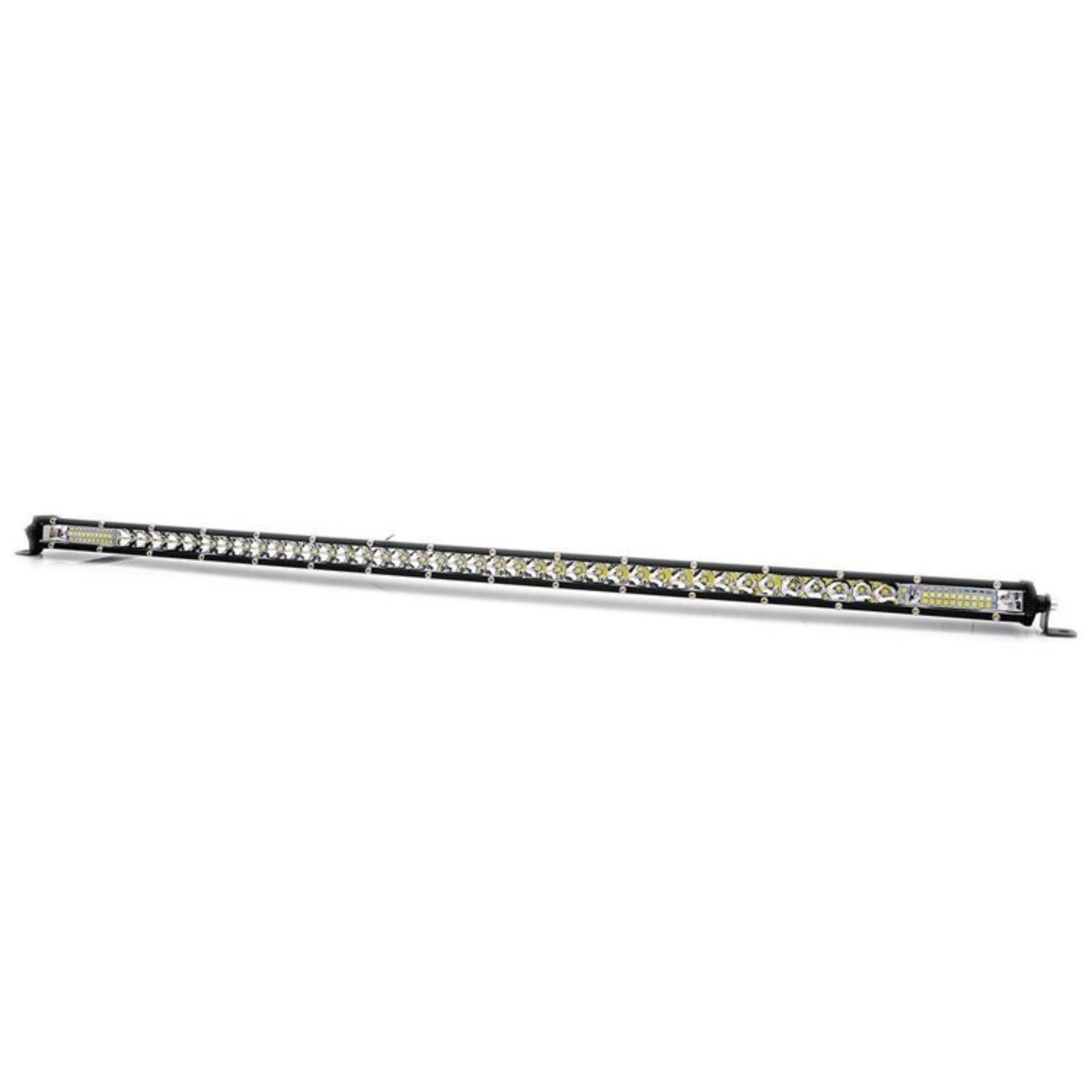- Part-Time 4WD
- 4 & 5-Speed TransmissionFront Disc Brakes
- Van Addition 1979
- Mid Engine
Honda’s Acty, introduced in 1977, is undoubtedly one of the most well-known vehicles in the kei truck category. After succeeding the Honda TN360, the Acty underwent production for 44 years, spawning several notable variations, such as its Van and Street models. The versatility of Honda Acty kei trucks diversified its appeal among demographics, which included, but weren’t limited to, small business owners navigating congested city streets, farmers and agricultural workers, and recreational users who enjoyed activities like off-road exploration and camping.
The Acty, nicknamed the NSX of the farm because of its unique mid-engine layout, evolved significantly throughout its generations. Below, you’ll find more information on these intriguing evolutions, key Acty specs, and how Oiwa Garage helps you realize your vision for owning one of these iconic vehicles.
Evolution of the Honda Acty
Over the decades, the Honda Acty has evolved from a simple utility truck into an icon of reliability and innovation. Each generation brought something new to the table. For a deep dive into what makes each iteration of this kei truck special, check out the details listed below.
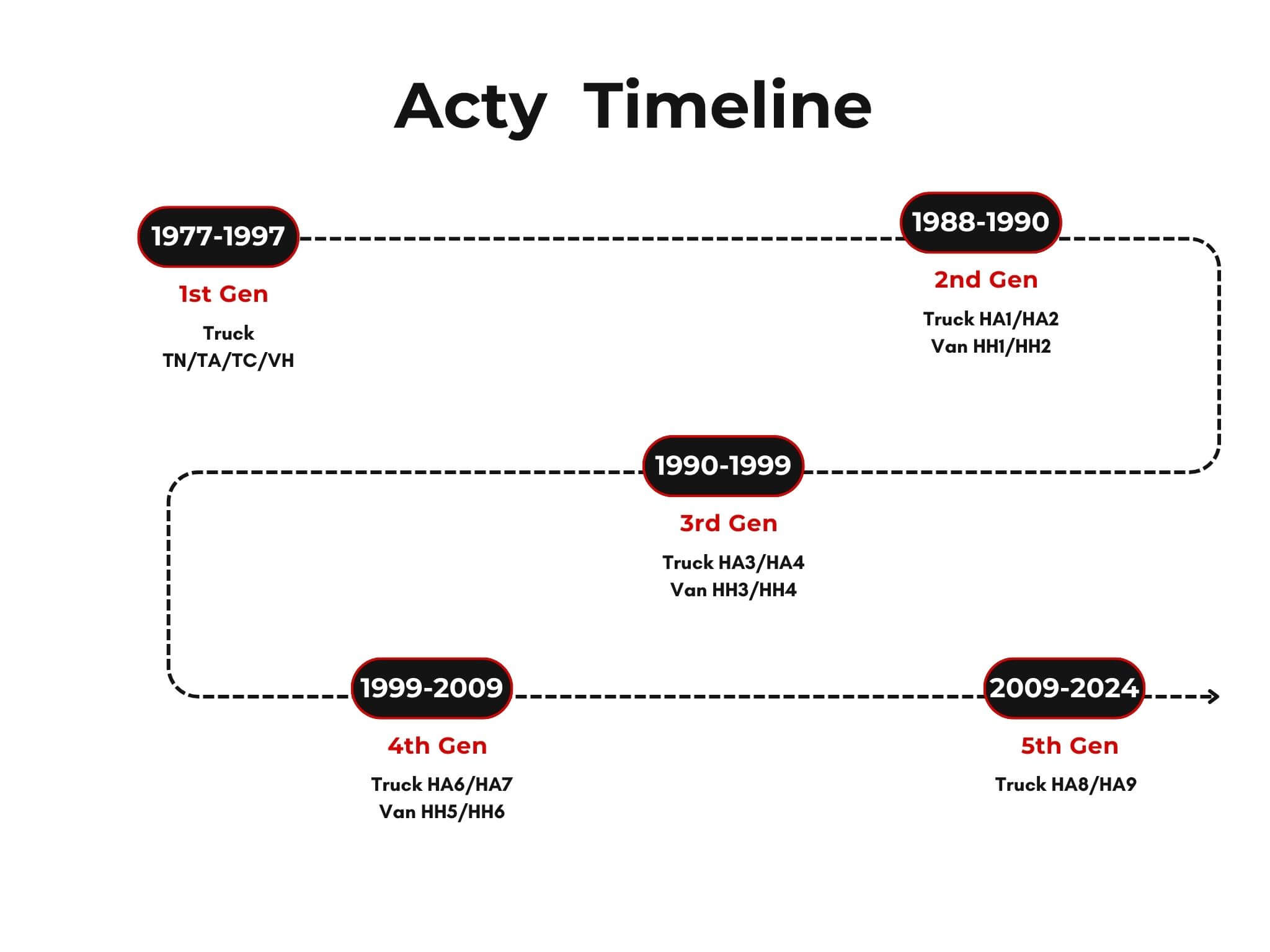
Breaking Ground: The Inception and Legacy of Honda’s First-Gen Acty (1977-1987)

KEY HIGHLIGHTS
POWERTRAIN DETAILS
- Engine: 545cc 2-Cylinder
- Fuel System: Carburetor
- Horsepower: 27.5hp
- Torque: 30 lb-ft
- Load Capacity: 772lbs
SIZE SPECIFICATIONS
- Body Height: 72.83 inches
- Body Length: 125.79 inches
- Body Width: 54.92 inches
- Truck Bed Height: 11.81 inches
- Truck Bed Length: 76.38 inches
- Truck Bed Width: 53.15 inches
VEHICLE WEIGHT
- 1300 lbs
Shifting regulations in Japan led to the Honda Acty’s genesis. In 1975, the country’s government changed its Road Trucking Vehicle law stipulating kei vehicle class body dimensions and engine sizes. First-generation Acty trucks came equipped with a 545cc two-cylinder water-cooled EH engine good for 27.5 horsepower and 30 lb.-ft. of torque. The engine featured a mid-mounted position for better weight distribution. During its launch, the debut Acty cost, not adjusted for inflation, was ¥533,000 ($3,712). With inflation, the price would’ve been around ¥1,376,000 ($9,494.40). Two years after releasing the Acty kei truck, Honda began selling its Acty van with a standard or high roof design.
In 1981, Honda launched its Street variation of the Acty van, which remained in production for two generations as a nicer version of the standard van model. The entire Acty lineup received four-wheel drive (4WD) disc brakes in 1983 and optional air conditioning in 1985. First-generation Actys were initially equipped with a 4-speed manual transmission, followed by an optional 2-speed Hondamatic automatic during the 1980s. These models also featured a cab-over configuration, which placed the driver and passengers on top of the front axle to optimize cargo space.
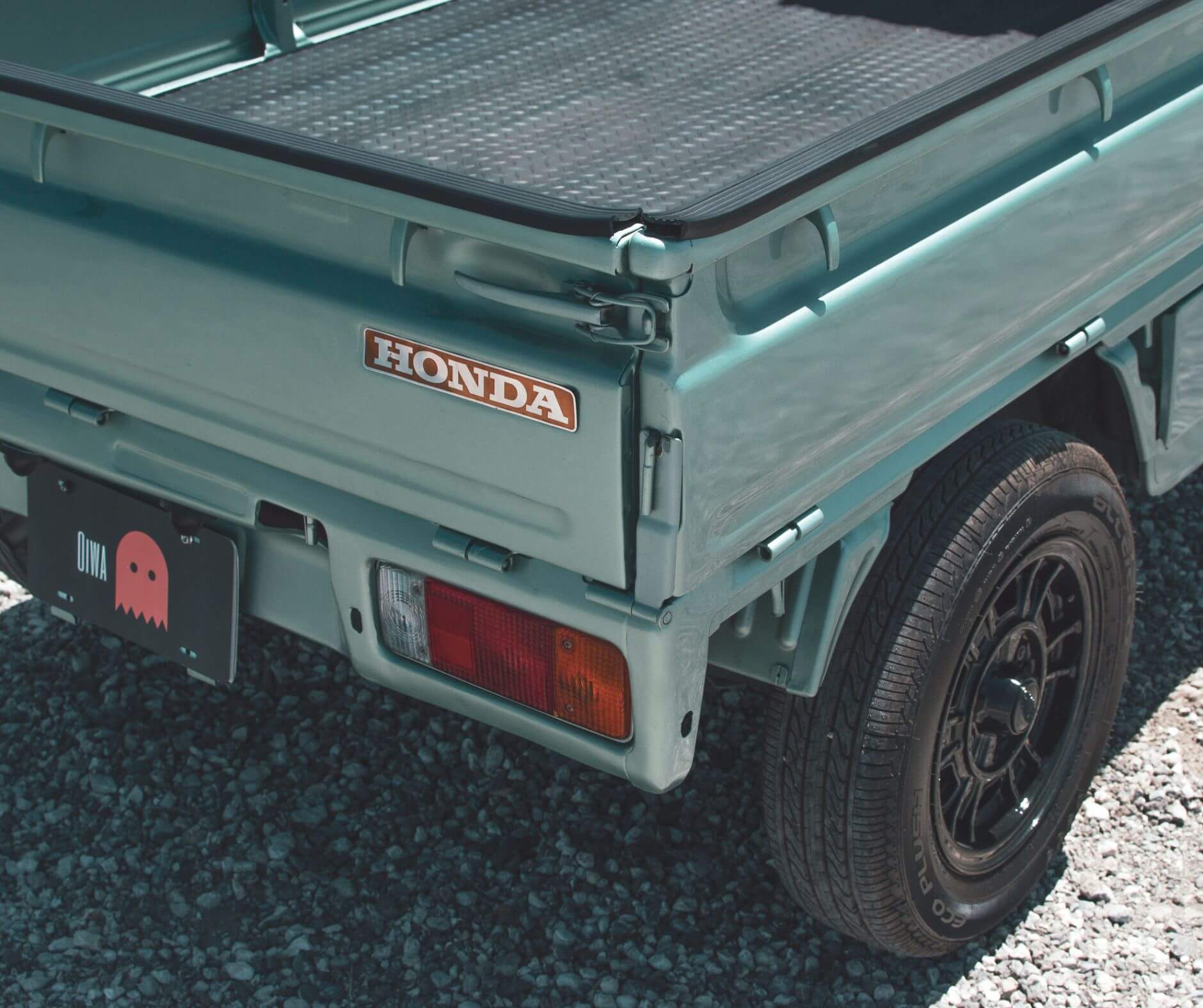
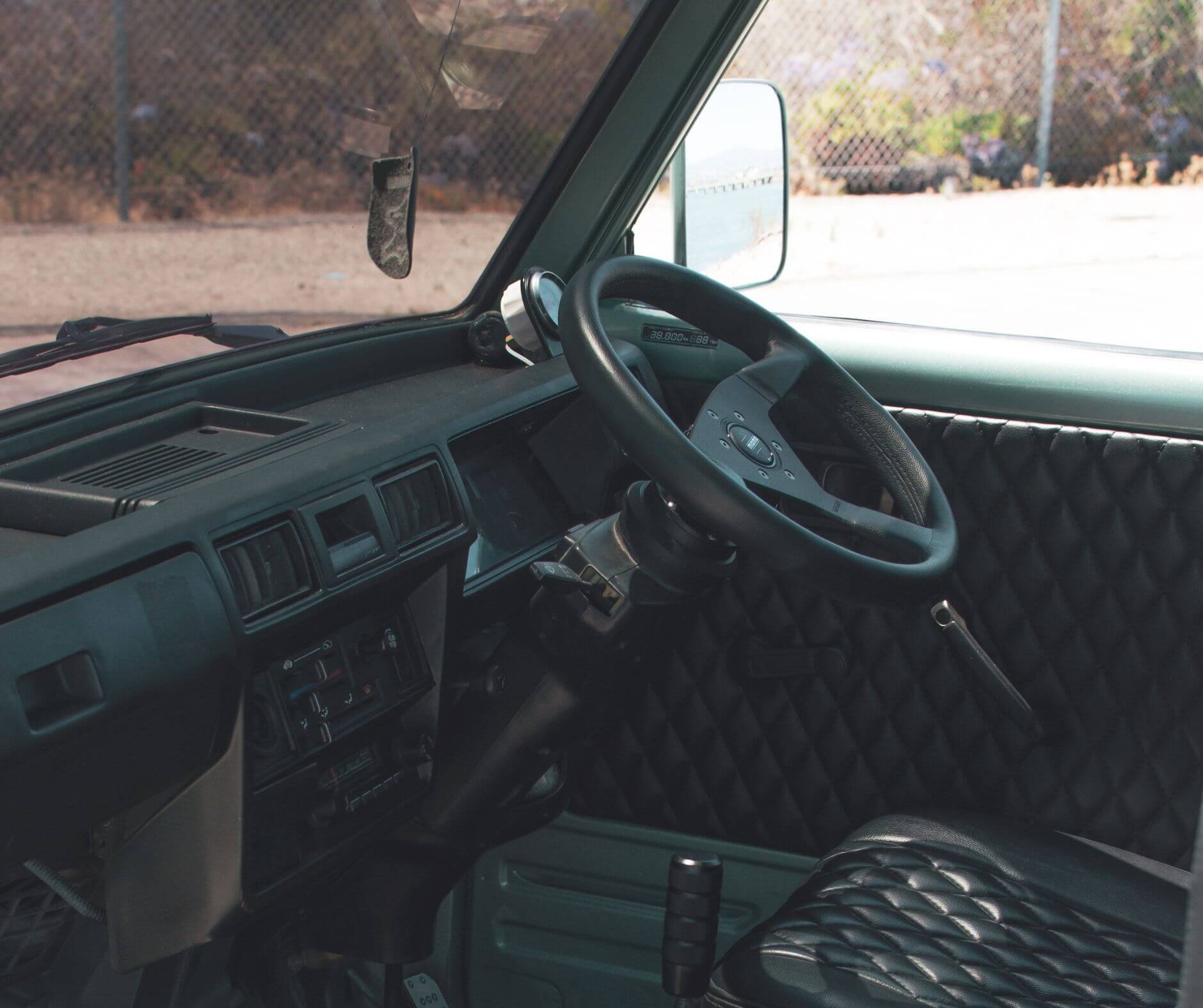
Decoding the Origins: Chassis Codes of the First-Gen Honda Acty
From 1977 to 1987 the Honda Acty was manufactured under the following chassis codes and spec (trim) levels.
| CHASSIS CODES | TA |
TC |
VD |
VH |
| Drivetrain | 2WD |
4WD |
2WD |
4WD |
| Engine | 545cc 2-Cyl |
545cc 2-Cyl |
545cc 2-Cyl |
545cc 2-Cyl |
| Vehicle Type | Truck |
Truck |
Van |
Van |
| Trim Level | TN Acty |
TN Acty |
Acty Van |
Acty Van |
Honda Acty Second Generation (Debut Model): 1988-1990
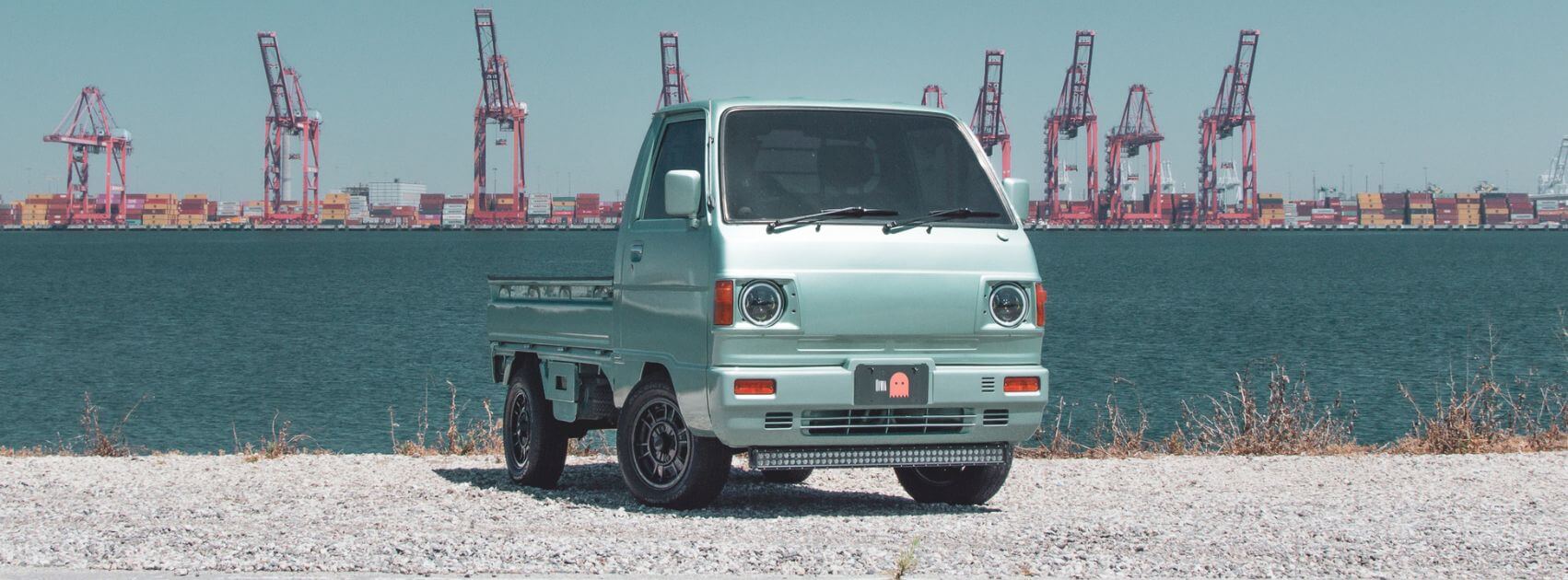
KEY HIGHLIGHTS
- E05A Engine Power
- Realtime 4WD
- Manual + Three-Speed Automatic
- Round Headlights (Truck/Van)
- Hexagonal Headlights (Street)
POWERTRAIN DETAILS
- Engine: 545cc 2-Cylinder
- Fuel System: Carburetor
- Horsepower: 27.5hp
- Torque: 30 lb-ft
- Load Capacity: 772lbs
SIZE SPECIFICATIONS
- Body Height: 72.83 inches
- Body Length: 125.79 inches
- Body Width: 54.92 inches)
- Truck Bed Height: 11.81 inches
- Truck Bed Length: 76.38 inches
- Truck Bed Width: 53.15 inches
VEHICLE WEIGHT
- 1300 lbs
Second-generation Actys brought new designs to the truck, van, and Street models, including specs like a E05A 550cc 3-cylinder engine with 34 horsepower and 33 lb.-ft. of torque. Honda also provided a three-speed automatic transmission alongside the 5-speed manual, a new Realtime 4WD system transferring power between wheels based on traction needs using an advanced clutch system, and round headlights. Alternatively, the Street van featured square-shaped headlights from 1982, which the truck would later receive.
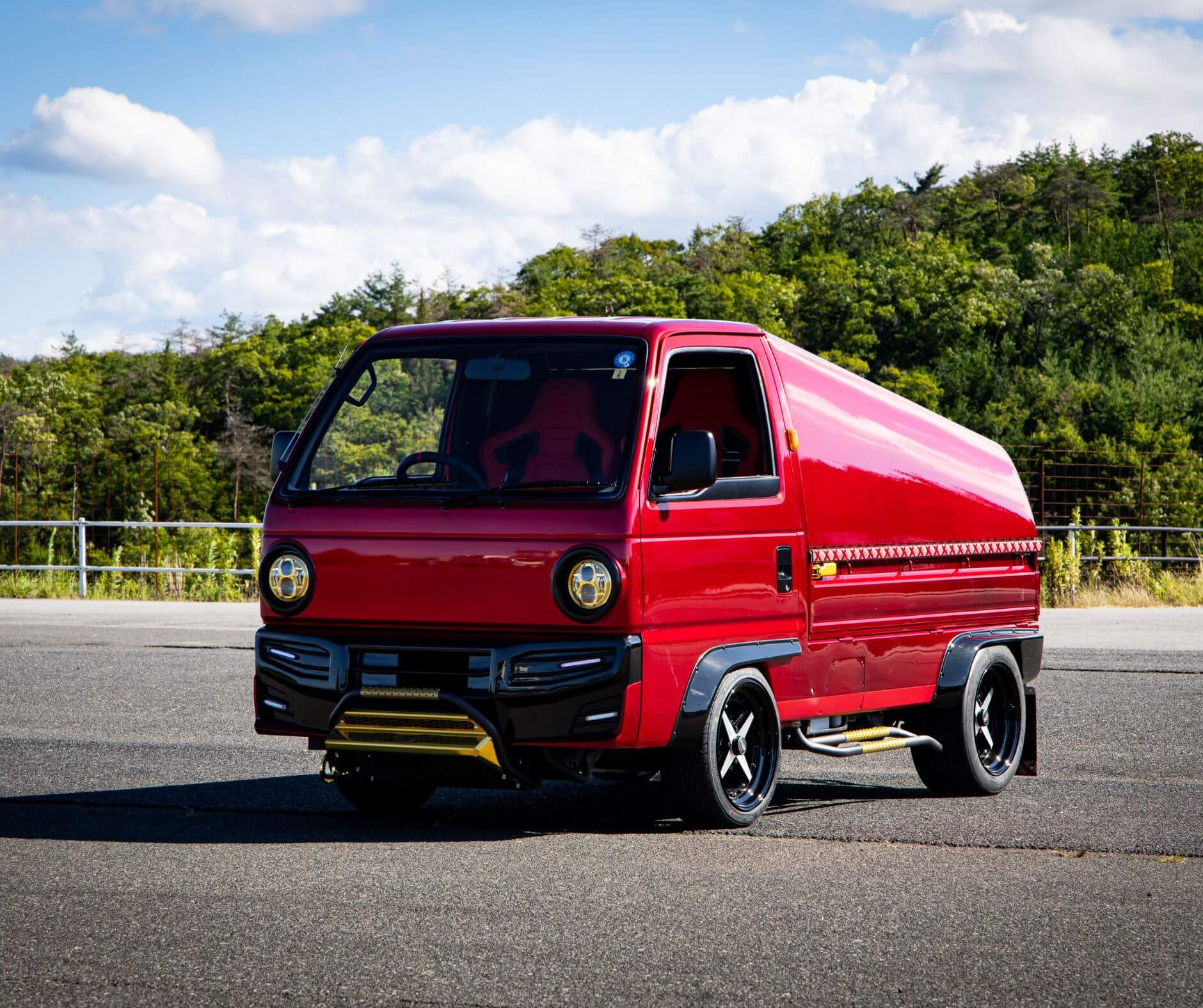
Drivers could choose between 18 different trim level variations. In 1988, Honda introduced the Acty Attack variant designed for agricultural applications with its rear differential lock and ultra-low forward and reverse gears providing controlled, slow movement on challenging terrain.
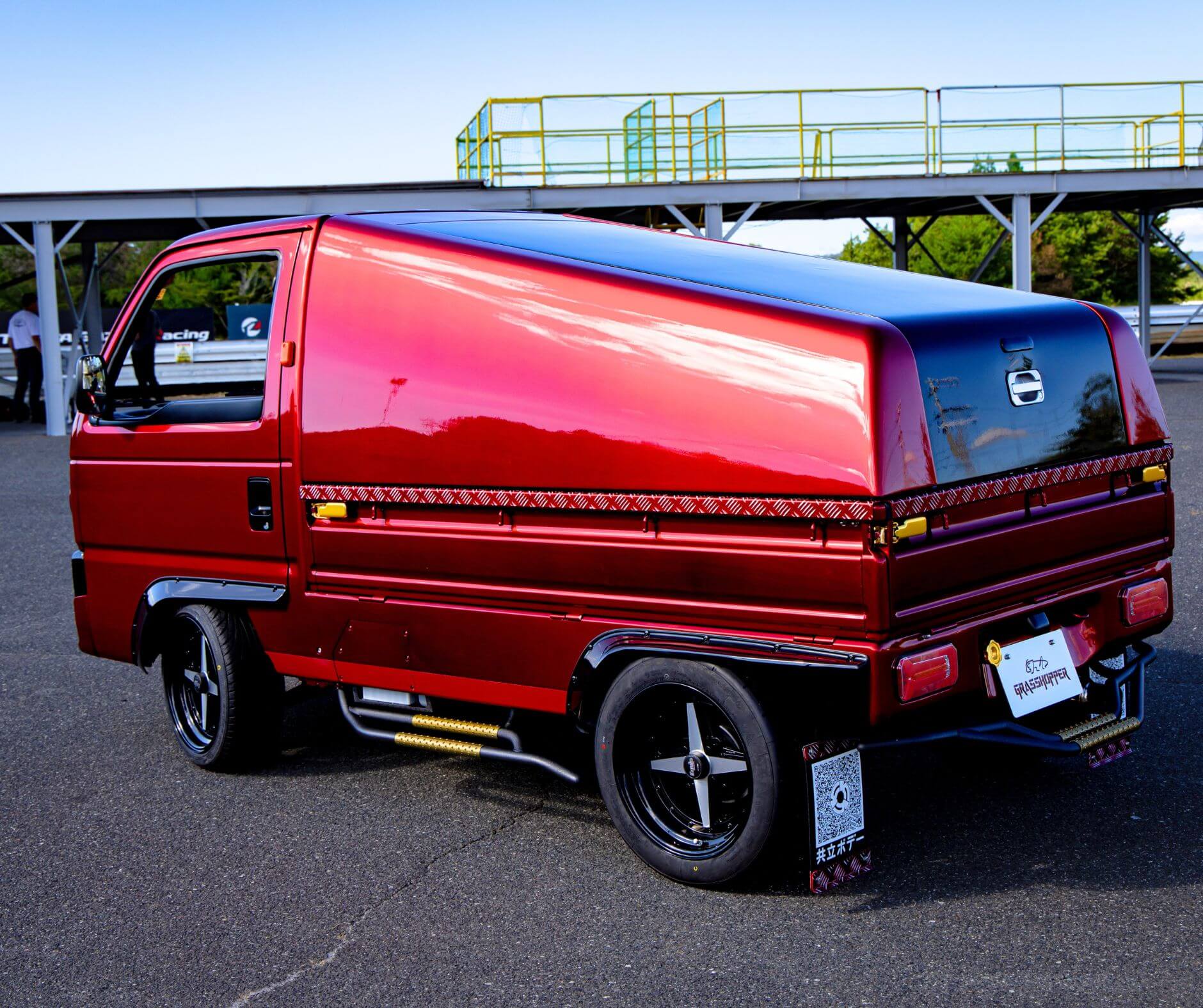
Second Generation (Debut) Honda Acty Chassis Codes
From 1988 to 1990 the Honda Acty was manufactured under the following chassis codes and spec (trim) levels.
| CHASSIS CODES | HA1 |
HA2 |
HH1 |
HH2 |
| DRIVETRAIN | 2WD |
4WD |
2WD |
4WD |
| POWERTRAIN | 550cc 3-Cyl |
550cc 3-Cyl |
550cc 3-Cyl |
550cc 3-Cyl |
| TRIM LEVELS | STD |
STX |
Acty Van PRO-B |
Acty Van PRO-B |
| VEHICLE TYPE | Truck |
Truck |
Van |
Van |
Honda Acty Third Generation (Refresh): 1990-1999

KEY HIGHLIGHTS
- E07A Engine
Increased Engine - Displacement
- 4 & 5-Speed Manual
- 3-Speed Automatic
- Fuel Injected Engine (Fox & Xi Vans)
- Realtime 4WD
- Locking Differentials(Attack & Crawler)
- Fuel Injection Upgrade
POWERTRAIN DETAILS
- Engine: E07A 656cc 3-Cylinder
- Fuel System: Carburetor /
- Electronic Fuel Injection
- Horsepower: 37.5hp
- Torque: 40 lb-ft
- Load Capacity: 772lbs
SIZE SPECIFICATIONS
- Body Height (Truck): 68.31 inches - 73.62 lbs (Van)
- Body Length (Truck): 128.15 inches - 129 inches (Van)
- Body Width (Truck & Van): 54.92 inches
- Truck Bed Height: 26.57 inches
- Truck Bed Length: 76.38 inches
- Truck Bed Width: 52.36 inches
VEHICLE WEIGHT
- 1697 lbs -1829 lbs
The Honda Acty’s third-generation refresh included updates like a more robust E07A 656cc 3-cylinder engine, which was again spurred by shifting Japanese government regulations. This engine delivered 37.5 horsepower and 40 lb.-ft. of torque. Separate noteworthy changes during the period were a 10 cm body extension and larger rectangular headlights with chamfered corners. 2WD versions received a four- or five-speed manual transmission, while 4WD models came with a 5-speed manual.
In 1993, Honda introduced its PGM-FI version of the Acty Street van—the Fox and Xi. Honda’s Xi PGM-FI was the premium trim offering a sunroof, power steering, and stereo system upgrade. Both the Fox and Xi benefitted from fuel injection, resulting in 44 horsepower and smoother performance than their carbureted counterparts. In 1994, Honda introduced the Acty Crawler as a special order vehicle, which contained treads on the tandem axles instead of rear wheels. Honda manufactured the Acty Crawler from 1994 to 1999. During this period, Honda changed the Acty Truck and Street’s front turn signals from amber to clear.

Keep reading to learn more about the Acty’s Attack and Crawler variations.
Exploring the Rarities: Unique Editions of the Honda Acty
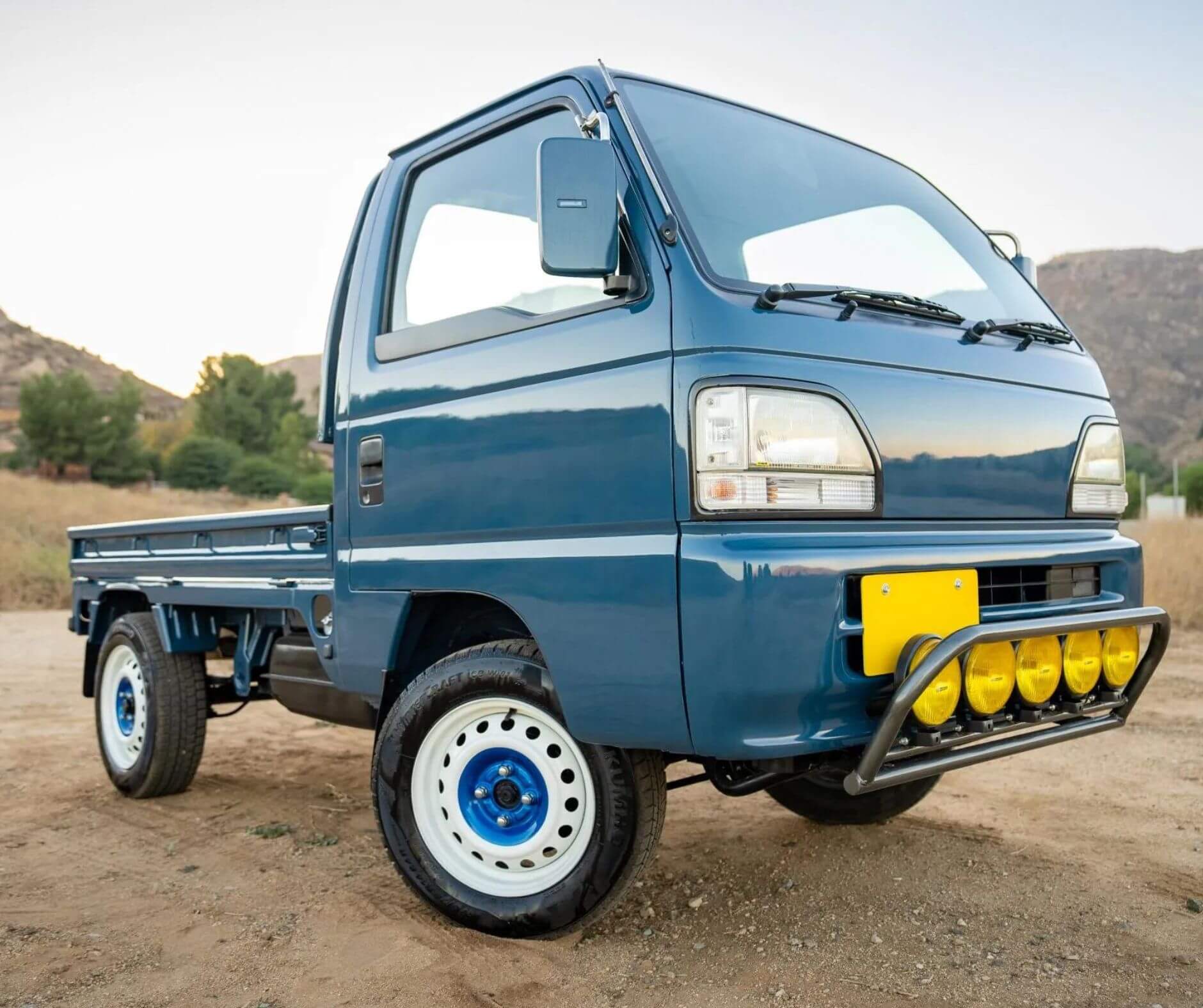
Acty Attack
The Acty Attack thrived in an array of off-road settings in addition to aforementioned agricultural applications like farming. These settings included but weren’t limited to forestry and logging, traversing mountainous, snowy, or muddy terrain, construction, and nature exploration. The Attack’s versatility partially stemmed from the model’s use of a 4-speed manual transmission with ultra-low forward and reverse gears—a configuration complemented by a rear differential lock increasing traction, a reinforced chassis, and a suspension system tuned to absorb shocks from uneven terrain. The Attack initially featured Honda’s E05A engine, which was replaced by the E07A engine after 1990. Honda capped the Acty Attack’s payload at 772 lbs in accordance with government limits.
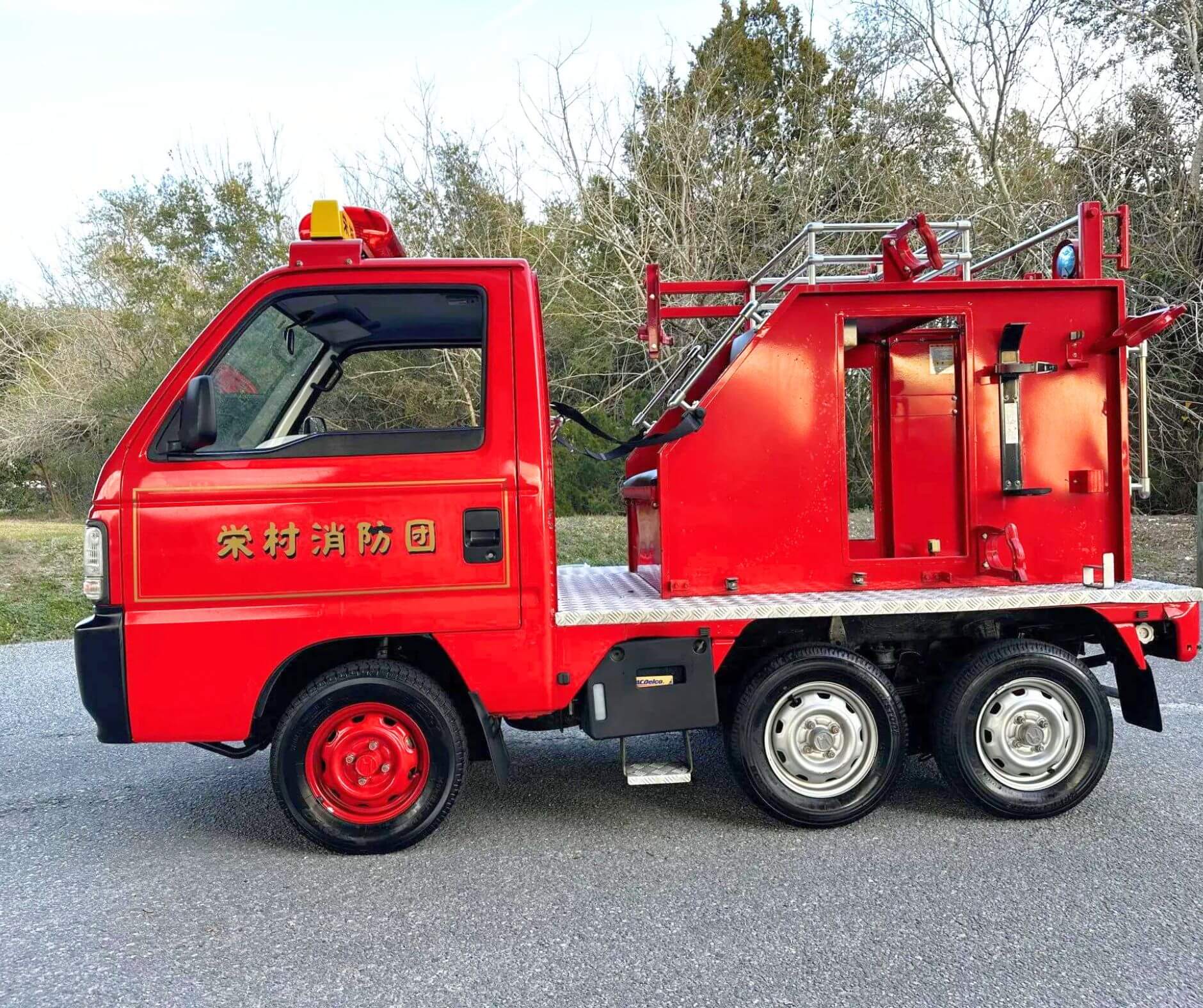
Acty Crawler
While the Acty Attack offered plenty of off-road capability, the Acty Crawler, designated the HA5, leveled up this performance with design elements accommodating more extreme off-road use. The Crawler’s previously mentioned dual rear axles and slip-on tank tracks were initially focused on traveling through mountainous Japanese terrain. This Acty variant contained Honda’s naturally aspirated 656cc E07A engine and a 5-speed manual transmission that sent power to four of the vehicle’s six wheels.
Despite its six-wheel design, this power distribution technically qualifies the Crawler as a 4X6 model. Nowadays, a Crawler can be seen as a viable alternative to 6x6 vehicle conversions, and its removable tracks allow the variant to transition between operating as an off-road titan and a standard on-road kei truck. Still, Honda had an option for a rear track and front-mounted skis for its 1969 TN360 kei truck named the Snowler.
Honda didn’t widely produce the Acty Crawler during the variant’s manufacturing run lasting from 1994 to 1999, which has contributed toward its status as a cult favorite among kei and off-road enthusiasts. Less than 500 Acty Crawlers hit streets, with 5 made as fire trucks. Only four of these five firetrucks are known to exist. In 2023, Bring a Trailer listed a 1996 Honda Acty Crawler fire truck for sale, which sold for $26,000 with 2,237 miles on its odometer. Acty Crawler fire trucks were originally built for the rugged terrain present at the 1998 Nagano Winter Olympics in Japan, and their noteworthy features included fire gear mounts, a siren, emergency lighting, and a PA system.
The Acty Crawler, along with the Acty Truck and Acty Van, began mirroring the trapezoidal face of the Acty Street van during its production run, which ran alongside a group of mid-engine 4WD vehicles consisting of legendary models like Lamborghini’s Diablo and Bugatti’s EB110.

Fuel-Injected Acty Street and Van Models
Starting in 1993, Honda Acty Street and Van models introduced fuel-injection tech into the Fox and Xi trims. Previous versions had contained carbureted engines, which focused on reliability. Fuel-injection engines provide the Acty Street and Van models with higher fuel economy thanks to better management of the air-fuel mixture, smoother responsiveness, lower emission outputs, and fewer maintenance requirements over time compared to carbureted motors.
While the Acty’s carbureted engines were reliable, they required frequent adjustments and tuning to retain optimal performance. These carbureted engines also gained a reputation for struggling with cold starts since they relied on a mechanical choke to enrich the air-fuel mixture manually. In contrast, the Acty Street and Van fuel injection systems automatically adjusted to temperature changes. Fuel-injected Acty Street and Van models were available in 2WD and 4WD, suitable for light off-road use. The 656cc three-cylinder unit produced 37.5 horsepower and 40 lb.-ft. of torque, and optional features like halogen headlights helped form a contemporary appearance.
Unveiling the Designations: Honda Acty’s Second-Gen Model Updates

The second-generation Honda Acty provided something for everyone through its upgraded standard models and special-edition variants. Check out the summary below highlighting this classic lineup’s chassis codes, drivetrains, powertrains, trim levels, and class types.
| CHASSIS CODES | HA3 |
HA4 |
HA5 |
HH3 |
HH4 |
| DRIVETRAIN | 2WD |
4WD |
4x6 |
2WD |
4WD |
| POWER TRAIN | 656cc 3-Cyl |
656cc 3-Cyl |
656cc 3-Cyl |
656cc 3-Cyl |
656cc 3-Cyl |
| TRIM LEVELS | STD |
STX |
Crawler |
Van STD |
Van PRO-B |
| VEHICLE TYPE | Truck |
Truck |
Truck |
Van |
Van |
The 21st Century Workhorse: Honda Acty’s 4th Generation (1999-2010)

KEY HIGHLIGHTS
- Longer Wheelbase
- Power Steering Standard
- Vamos Replaces Street
- Driver’s Airbag Standard
- Commercial Series Options
- Automatic 4WD Available
POWERTRAIN DETAILS
- Engine: E07Z 656cc 3-Cylinder
- Fuel System: Electronic Fuel Injection
- Horsepower: 45.5hp
- Torque: 45 lb-ft
- Load Capacity: 772lbs
SIZE SPECIFICATIONS
- Body Height: 68.7 inches
- Body Length: 133.66 inches
- Body Width: 58.07 inches
- Truck Bed Height: 11.42 inches
- Truck Bed Length: 76.38 inches
- Truck Bed Width: 55.51 inches
VEHICLE WEIGHT
- 1741 lbs - 1918 lbs
Honda debuted the fourth-generation Acty truck in May 1999—one month before releasing the van version. Japanese Government revisions to its Enforcement Regulations Vehicle Law triggered the model’s genesis in September 1996. These revisions posed automakers like Honda with higher safety requirements for front passengers but didn’t make any alterations to legal body dimensions—creating a challenge for engineers. Honda responded by moving the driving position back and retaining the engine’s mid-mount configuration under the bed while adding a new small bonnet (hood), which marked a significant departure from previous versions. While making changes to increase safety for the third-generation Acty, Honda also improved this model’s comfort and performance.
The automaker nixed its Street van with the third generation to make room for a new passenger-focused van named the Vamos, which expanded the Acty’s appeal beyond traditional commercial users. Honda marketed the Town trim as its top-level Acty grade, which was available for both trucks and vans, but primarily trucks. The truck’s standard was the SDX (Super Deluxe). This generation also featured three commercial series of Actys, including the Powerful Series, Fresh Delivery Series, and Utility Series, with features supporting business and commercial activities differentiating each series. Commercial features included a dump bed, hydraulic lift, freezer cargo box, refrigerated cargo box, and more. When selecting a dump truck Acty, drivers could select a standard deep or shallow bed, along with a 2WD or 4WD configuration.
Drivers received a more powerful and fuel-efficient 660cc three-cylinder engine with a manual, automatic, or CVT (Continuously Variable Transmission) producing 52 horsepower and 45 lb.-ft. of torque. The CVT provided better fuel economy and was smoother than traditional automatic transmissions, helping earn the LEV (Low Emissions Vehicle) designation. These specs were complemented by a better suspension and improved handling for on- and off-road use. Regarding design, the third-generation Acty adopted a more refined look with softer and more contemporary lines. At the same time, the interior received higher-quality materials, increasing comfort and durability in addition to improved ergonomics, such as an intuitive dashboard layout providing easier access to controls.
Key safety additions included Honda implementing ABS (Anti-Lock Braking System), dual front airbags, and power steering, which facilitated improved navigation through tight spaces. The third-generation Acty saw improved crash test ratings for passenger and pedestrian collisions alike, showcasing the engineer’s ability to turn an uphill battle into a successful product. Third-generation Actys ultimately appealed to drivers seeking a balance of style and functionality.
Unlocking the Legacy: Model Designations of the Fourth-Gen Honda Acty
The fourth Honda Acty introduced numerous noteworthy developments, underscoring the importance of knowing information about chassis codes, drivetrains, powertrains, trim levels, and vehicle types.
| CHASSIS CODES | HA6 |
HA7 |
HH5 |
HH6 |
| DRIVETRAIN | 2WD |
4WD |
2WD |
4WD |
| POWERTRAIN | 656cc 3-Cyl (EFI) |
656cc 3-Cyl (EFI) |
656cc 3-Cyl (EFI) |
656cc 3-Cyl (EFI) |
| TRIM LEVELS | STD |
SDX |
PRO-B |
PRO-B |
| VEHICLE TYPE | Truck |
Truck |
Van |
Van |
The Modern Evolution: Honda Acty’s 5th Generation (2009 to 2018)

KEY HIGHLIGHTS
- HA8/HA9 Chassis Codes
- Power Windows
- Wheel Well Repositioning
- Keyless Entry (Town Trim)
- Final Production 2021
POWERTRAIN DETAILS
- Engine: E07Z 656cc 3-Cylinder
- Fuel System: Electronic Fuel Injection
- Horsepower: 44.5hp
- Torque: 43.52 lb-ft
- Load Capacity: 772 lbs
SIZE SPECIFICATIONS
- Body Height: 68.7 inches
- Body Length: 133.66 inches
- Body Width: 58.07 inches
- Bed Height: 11.42 inches
- Bed Length: 76.38 inches
- Bed Width: 55.51 inches
VEHICLE WEIGHT
- 1697 lbs - 1830 lbs
Honda’s fifth-generation Acty, produced from 2009 to 2018, featured changes for the truck version, while the van retained its third-generation body design until its discontinuation in July 2018, leading to the N-Van. The fourth-generation Acty kept features largely consistent with the previous generation, helping solidify the model’s reputation as a fuel-efficient, practical, compact, and light commercial vehicle. Chassis codes were the same as the third-generation at HA8 for 2WD and HA9 for 4WD, but the top-tier Town trim now offered available keyless entry and power windows.
The Attack variant contained Ultra-Low forward and reverse gears, a 5-speed manual transmission that came standard in all 4WD versions, and a locking rear differential, increasing its popularity among farmers and other outdoor workers. Honda sold 2WD fourth-generation Actys with a 3-speed, 4-speed, or 5-speed manual transmission. Dump beds, cargo boxes, and lifts received subtle modifications, increasing efficiency. The midship layout remained the same with the motor placed behind the cabin underneath the truck’s bed, but the wheelbase was shortened to optimize cabin space and the turning radius. The wheelbase was shortened to 1.9 meters or 6.2 feet, the same measurement as the second-generation Acty. Cabin space was also increased by the wheel wells placement under the passenger seats, aiding truck entries and exits.
Honda made minor modifications to the fourth-generation Acty in 2012 to meet new lighting standards. Fourth-generation Honda Actys continued using the previous generation’s 656cc E07Z engine, but the power output was reduced to 44 horsepower and 43 lb.-ft. of torque. However, a 39.5 to 49 MPG fuel efficiency, depending on drivetrain specs, helped this model maintain its fanbase. In 2018, Honda sold the fourth-generation Acty Spirit Color Style, including two-tone bay blue and white, flame red, and black configurations. Additionally, the Acty could be ordered with silver and black paint for the first time. Honda introduced ABS during the Acty’s third generation as optional, but the feature became standard across all Acty trims during the model’s fourth generation.
Competitors mainly had shifted to front-engine designs by this time, but Honda always designed its Acty with a mid-engine layout. Daihatsu’s Hijet adopted a front-engine configuration in 1994 by introducing the S100 Series, Suzuki’s Carry and Mitsubishi’s Minicab implemented a front-engine design in 1999, and Subaru’s Sambar eventually made the change in 2012. These Acty rivals changed the engine placement to provide better crash protection while increasing cabin space and comfort. However, Honda primarily chose to keep its mid-engine design for better weight balance, highlighting the automaker’s dedication to utility.
The Legacy Continues: Model Designations of the Fifth-Gen Honda Acty

Streamline your knowledge of the fourth-generation Honda Acty’s chassis codes, drivetrains, and powertrain specs with the chart below.
| CHASSIS CODES | HA8 |
HA9 |
| DRIVETRAIN | 2WD |
4WD |
| POWERTRAIN | 656cc 3-Cyl (EFI) |
656cc 3-Cyl (EFI) |
| TRIM LEVELS | STD |
SDX |
| VEHICLE TYPE | Truck |
Truck |
The Modern Evolution: Honda Acty’s 6th Generation (2018 to 2021)
The 6th-generation Honda Acty emphasized safety, driver assistance technology, and comfort more than performance. Honda sold multiple fifth-generation Acty trims, including the STD (Standard), SDX (Super Deluxe), and the Attack variant, which continued to thrive in off-road and agricultural applications. The fifth generation maintained the Acty’s squared-off body design to optimize interior and cargo space while offering modern features like LED headlights. Honda’s final Acty generation retained the dimensions of its fourth-generation predecessor—as dictated by Japanese regulations. The length was 3,395 mm (133.7 inches), width 1,475 mm (58.1 inches), and height 1,880 mm (74 inches), making it adept at navigating congested urban streets and moving in and out of tight parking spaces.
Honda’s 6th-generation Acty maintained the previous generation’s 660cc three-cylinder engine with 44 horsepower and 43 lb.-ft. of torque while selling the model in 2WD and 4WD configurations, with the 4WD models featuring Honda’s Realtime 4WD system. The Realtime 4WD system automatically engaged the rear wheels when the front wheels lost traction, providing additional support during off-road or adverse condition driving. Honda refined the suspension to smoothen out rides for situations like heavy load carrying, and the front contained independent struts, while the rear featured a semi-independent design. Drivers would receive a standard 5-speed manual transmission with 4x4 trims, but 2WD versions could come with a 4-speed manual, 5-speed manual, or 3-speed automatic. Power steering became standard on all trims, and fuel economy ranged between 35 and 42 MPG, depending on the drivetrain.
Safety innovations within the fifth-generation Acty included the installation of Honda Sensing tech with advanced driver-assistive features like a Collision Mitigation Braking System (CMBS), Road Departure Mitigation (RDM), Adaptive Cruise Control (ACC), dual front airbags, an anti-lock braking system (ABS), and electronic brake-force distribution (EBD). Hill-Start Assist was included on some trims to help prevent or mitigate rollback on inclines.
Honda ended the Acty in 2021 due to market conditions like rising production costs associated with stricter emissions and safety. More specifically, developing the mandatory crash mitigation brakes was getting more expensive. After Honda retired the Acty, kei models like the N-Van came along, and the automaker shifted its focus toward developing electric vehicles (EVs). In 2022, Honda began developing its electric version of the N-Van, the N-Van e, with the model’s subsequent launch occurring in October 2024. The N-Van e costs $15,500 in Japan.
Experience the Ideal Acty Ownership Experience with Oiwa Garage
Whether you’re searching for first, second, third, fourth, or fifth-generation Acty truck or van components—Oiwa Garage simplifies your search for parts with a comprehensive inventory of categorized parts. Honda Acty truck owners can find parts for HA3, HA4, HA6, HA7, HA8, and HA9 chassis codes, while Acty van enthusiasts can access HH3, HH4, HH5, and HH6 components.
Are you unsure where to start your Acty parts search? Perhaps you’re looking to purchase a Honda Acty Truck or Van and need assistance with the buying process. Oiwa Garage is here to help! Contact us today for qualified support.
We've Got The Acty Parts You Need
We have a wide selection of Kei Truck Parts available, and we’re constantly adding more to our inventory. Take a look through our store to see what we have available, or let us know if you’re looking for something specific.
Learn About Other Kei Trucks
Kei trucks are the perfect blend of small size and big utility. Each Japanese automaker brings its own twist, but they all follow strict kei rules, making these compact trucks efficient and tough. Explore the lineup and see how these tiny trucks pack a big punch.






The details of the this page were sourced by our own industry expertise, as well as content from the following websites:
Goo-Net
Honda Japan
Car Aid
ActyFan
Bring a Trailer
Honda Japan
Goo-Net
Wikipedia
Round Cat Racing
If you wish to use this page as source, please insert out URL hyperlink into your content for credit and contact us at oiwagarage.mail@gmail.com / 562-662-8859






